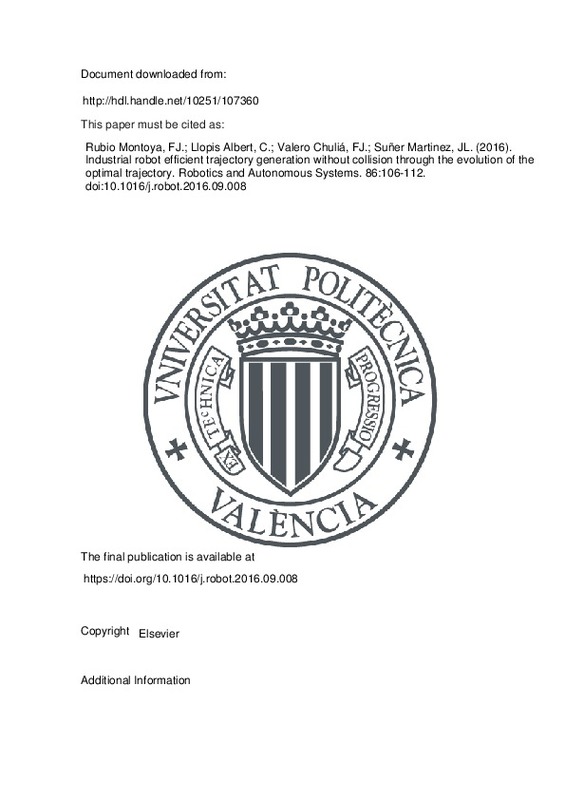JavaScript is disabled for your browser. Some features of this site may not work without it.
Buscar en RiuNet
Listar
Mi cuenta
Estadísticas
Ayuda RiuNet
Admin. UPV
Industrial robot efficient trajectory generation without collision through the evolution of the optimal trajectory
Mostrar el registro sencillo del ítem
Ficheros en el ítem
| dc.contributor.author | Rubio Montoya, Francisco José
|
es_ES |
| dc.contributor.author | Llopis Albert, Carlos
|
es_ES |
| dc.contributor.author | Valero Chuliá, Francisco José
|
es_ES |
| dc.contributor.author | Suñer Martinez, Josep Lluis
|
es_ES |
| dc.date.accessioned | 2018-09-17T07:09:57Z | |
| dc.date.available | 2018-09-17T07:09:57Z | |
| dc.date.issued | 2016 | es_ES |
| dc.identifier.issn | 0921-8890 | es_ES |
| dc.identifier.uri | http://hdl.handle.net/10251/107360 | |
| dc.description.abstract | [EN] An efficient algorithm is presented to obtain trajectories for industrial robots working in industrial environments. The procedure starts with the obtaining of an optimal time trajectory neglecting the presence of obstacles. When obstacles are considered, the initial trajectory (obtained by neglecting obstacles) will not be feasible and will have to evolve so that it can become a solution. In this paper, the way that it evolves until a new feasible collision-free trajectory is obtained considering the possible obstacles is described. This is a direct algorithm that works in a discrete space of trajectories, approaching the global solution as the discretization is refined. The solutions obtained are efficient trajectories near to the minimum time one and they meet the physical limitations of the robot (the maximum values of torque, power and jerk are considered for each actuator), avoid collisions, and take into account the constraint of energy consumed. Examples already published and new examples in real industrial environments have been solved to verify the working of the algorithm. | es_ES |
| dc.description.sponsorship | This paper has been made possible thanks to support from the Spanish Ministry of Education, Culture and Sports through the Project for Research and Technological Development with ref. DPI2013-44227-R. | en_EN |
| dc.language | Inglés | es_ES |
| dc.publisher | Elsevier | es_ES |
| dc.relation.ispartof | Robotics and Autonomous Systems | es_ES |
| dc.rights | Reserva de todos los derechos | es_ES |
| dc.subject | Robot dynamics | es_ES |
| dc.subject | Nonlinear optimization | es_ES |
| dc.subject | Trajectory planning | es_ES |
| dc.subject | Industrial robots | es_ES |
| dc.subject | Modelling robots | es_ES |
| dc.subject.classification | INGENIERIA MECANICA | es_ES |
| dc.title | Industrial robot efficient trajectory generation without collision through the evolution of the optimal trajectory | es_ES |
| dc.type | Artículo | es_ES |
| dc.identifier.doi | 10.1016/j.robot.2016.09.008 | es_ES |
| dc.relation.projectID | info:eu-repo/grantAgreement/MINECO//DPI2013-44227-R/ES/METODOLOGIA DE DISEÑO DE SISTEMAS BIOMECATRONICOS. APLICACION AL DESARROLLO DE UN ROBOT PARALELO HIBRIDO PARA DIAGNOSTICO Y REHABILITACION/ | es_ES |
| dc.rights.accessRights | Abierto | es_ES |
| dc.date.embargoEndDate | 2018-12-31 | es_ES |
| dc.contributor.affiliation | Universitat Politècnica de València. Departamento de Ingeniería Mecánica y de Materiales - Departament d'Enginyeria Mecànica i de Materials | es_ES |
| dc.description.bibliographicCitation | Rubio Montoya, FJ.; Llopis Albert, C.; Valero Chuliá, FJ.; Suñer Martinez, JL. (2016). Industrial robot efficient trajectory generation without collision through the evolution of the optimal trajectory. Robotics and Autonomous Systems. 86:106-112. https://doi.org/10.1016/j.robot.2016.09.008 | es_ES |
| dc.description.accrualMethod | S | es_ES |
| dc.relation.publisherversion | https://doi.org/10.1016/j.robot.2016.09.008 | es_ES |
| dc.description.upvformatpinicio | 106 | es_ES |
| dc.description.upvformatpfin | 112 | es_ES |
| dc.type.version | info:eu-repo/semantics/publishedVersion | es_ES |
| dc.description.volume | 86 | es_ES |
| dc.relation.pasarela | S\318529 | es_ES |
| dc.contributor.funder | Ministerio de Economía, Industria y Competitividad | es_ES |







![[Cerrado]](/themes/UPV/images/candado.png)

